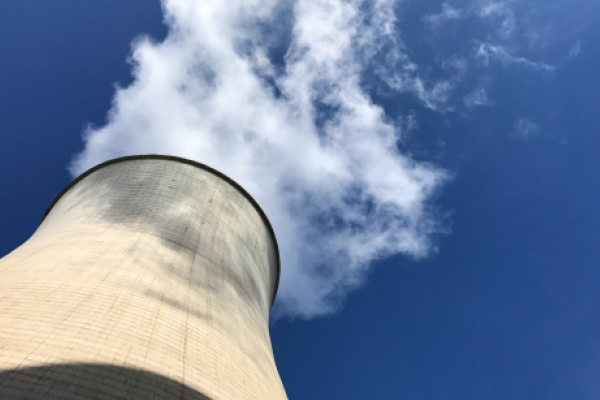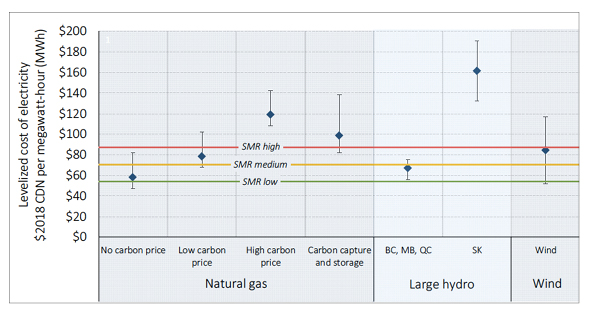
Getting “Serious” About Climate Change: The Case for Nuclear
The fundamental reason democracies avoid “serious” climate change policy is that the majority of the electorate rarely give a high priority to events that occur beyond one or two decades. Mark Carney has labeled this problem as the “tragedy of the horizon”.
By John Richards, Professor of Public Policy, Simon Fraser UniversityDownload this issue of JSGS Policy Brief.
On the one hand, liberal greens will tell you that the world is ending—but that we must not use nuclear power, an abundant source of clean energy, to stave it off. On the other hand, conservative greens will tell you that the world is ending, but that we can’t burden people with a carbon tax or a gasoline tax to slow global warming.
On a third hand, suburban greens will tell you that the world is ending, but that they don’t want any windmills, solar farms or high-speed rail lines in their backyards. On a fourth hand, most of today’s leaders will tell you that the world is ending, so at Glasgow they’ve all decided to go out on a limb and commit their successors’ successor to deliver emissions-free electricity by 2030, 2040 or 2050—any date that doesn’t reqnuclearuire them to ask their citizens to do anything painful today.
This is not serious—not when you’re talking about reversing all the ways that we have destabilized Earth’s systems, from ice caps and ocean currents to coral reefs and tropical forests to the density of carbon dioxide in the atmosphere. This is pretend.
Serious was how we responded to Covid-19, when it really did feel like the world economy was ending: We fought back with the only tools we have that are as big and powerful as Mother Nature—Father Profit and New Tech.” - Tom Friedman, New York Times (17 November 2021)
Friedman succinctly makes a cogent argument.1 With exceptions, the political leaders speaking at the Glasgow UN Congress of the Parties (COP26) were not “serious”. Perhaps the most ominous evidence of lack of seriousness is s.36 of the Glasgow Climate Pact:
s.36 Calls upon Parties to accelerate the development, deployment and dissemination of technologies, and the adoption of policies, to transition towards low-emission energy systems, including by rapidly scaling up the deployment of clean power generation and energy efficiency measures, including accelerating efforts towards the phase-out of unabated coal power and inefficient fossil fuel subsidies, recognizing the need for support towards a just transition.2
Optimists note that this is the first mention in a COP statement of eliminating use of coal to generate electricity; realists note that, at the last minute, India and China amended the text by substituting “phase down” in lieu of “phase-out”.
Whatever the interpretation, s.36 is not “serious” in Friedman’s terms. His implicit definition of “serious” is that politicians invest their political capital in launching programs that: 1) are undertaken now, as opposed to programs scheduled to ramp up over time or come into effect in future decades; and, 2) have potential to make a major impact in lowering greenhouse gas emissions (GHGs).
The fundamental reason democracies avoid “serious” climate change policy is that the majority of the electorate rarely give a high priority to events that occur beyond one or two decades. Mark Carney has labeled this problem as the “tragedy of the horizon”.3 Another way to summarize is that, even using a low discount rate (say 2 per cent) on future events, the present value of avoiding future climate costs, however large the undiscounted costs, is unlikely to exceed the present value of here and now costs of implementing “serious” programs.
The International Panel on Climate Change (IPCC) is a UN organization responsible for assembling climate change scientific studies. In a 2018 report targeting policy makers, it put forward four pathways that would probably hold the increase in average world temperature to +1.5 degrees Celsius, relative to pre-industrial estimates (see Box 1).
Box 1: IPCC Pathways to Limit Future Temperature Rise to 1.5 degrees Celsius
Pathway 1: Requires that innovations can simultaneously reduce energy demand and increase living standards, especially in the global South. A downsized energy system enables rapid decarbonization of energy supply. Afforestation is the only carbon dioxide removal option considered. There is no need for either fossil fuels with carbon capture and storage or bioenergy.
Pathway 2: Requires faith in international cooperation with a focus on sustainability including energy intensity, human development, economic convergence, shifts toward sustainable and healthy consumption patterns (e.g., substitution of plant-based protein for red meat), low-carbon technology innovation and well-managed land systems. Requires some limited societal acceptability for carbon capture and storage, and bioenergy.
Pathway 3: Implies that social as well as technological development follows historical patterns. In other words, final energy demand continues to grow. Central to this pathway is that we support universal acceptance of nuclear power. The scenario projects a fivefold increase in use of nuclear, a ninefold increase in non-biomass renewables and a sevenfold increase in carbon capture and storage plus bioenergy. (At present, adding carbon capture from fossil-fuel power generation roughly doubles the cost per kilowatt-hour).
Pathway 4: A resource- and energy-intensive scenario in which economic growth and globalization lead to widespread adoption of greenhouse-gas-intensive lifestyles, including high demand for transportation fuels and livestock products. Emissions reductions are mainly achieved through technological means. We need faith in new technology removing carbon dioxide from the atmosphere, faith in carbon capture and storage and faith in bioenergy fuels.
Souce: Summary of pathways defined in IPCC. 2018. Summary for Policymakers (p.14)
Each pathway requires policies that, at present, is highly unpopular in high-income countries and/or depends on technological innovation that may or may not materialize. The first requires reduced world energy demand, massive increase in forest cover, and emphasis on increased living standards in the global South. The second requires high levels of international co-operation, lower energy intensity, and major shift in diets from meat to plant-based protein. The third assumes extrapolation of historical trends in energy use. Central to this pathway is massive increase in share of energy derived from nuclear power, also an increase in non-biomass renewables, and in carbon capture and storage. The fourth requires optimistic trends in technology for CO2 removal from the atmosphere and faith in carbon capture and storage.
The Value of the Pathways is to Illustrate “Serious”
The first pathway requires Brazil, Indonesia, countries in tropical Africa, and Russia, among others, to halt illegal logging and find ways to expand forest cover. It also requires that the global North reduce energy demand and leave room for the global South to increase fossil-based energy use without endangering the +1.5 degree temperature cap. All good ideas, but they require Scandinavian quality of governance. The second requires that the world abandon meat, especially red meat. Good luck in persuading the majority across the world to become vegetarians, or perhaps eat chicken along with vegetables, fruit, and pulses. (No fish: substituting fish for meat accentuates pressure on endangered world fish stocks.) The IPCC is dubious about realization of the technological innovations required by the fourth.
The third pathway is the most viable. The case for it is that the majority in all countries—developing or high-income—will never agree to “phase down” or “phase out” fossil fuel energy without a reasonable substitute source of energy. As with the three other pathways, the third faces obstacles. Relative to 2010, it assumes a doubling of nuclear power capacity by 2030 and a five-fold increase by 2050. It undeniably poses serious problems. What about disposal of spent fuel? What about more Fukushimas? What about the history of cost over-runs on ex ante construction cost estimates? The obscure white paper discussed below answers the questions adequately.
The good news about this pathway is the consensus among engineers that (relatively) small modular reactors (SMRs) are much safer than large earlier designs. Furthermore, engineers expect that use of standardized modular components will enable lower construction costs (per MW capacity) than earlier designs for much larger reactors. In 2018, a committee composed of a half dozen Canadian power companies as voting members and Natural Resources Canada as a non-voting member published a white paper on the potential to construct multiple SMRs.4 While the white paper addresses the technical questions, it does not address the major problem: public opinion in most high-income countries, including Canada, is opposed to expansion of nuclear power. One recent Canadian survey found overwhelming support for substituting renewable and “clean” energy over fossil-fuel based energy, but only 21 per cent were prepared to endorse nuclear as a clean energy option.5
Despite public attitudes, nuclear is making a comeback among some of the world’s “deep thinkers” with deep pockets. The Union of Concerned Scientists, a respected group of scientists, publishes carefully researched reports on numerous US policy issues. In 2018, UCS published a monograph advocating expanded investment in US nuclear power capacity.6 In a recent issue (13 November 2021), The Economist published an editorial and two articles on the potential of nuclear power in reducing greenhouse gases associated with power generation. All three are positive. Bill Gates has decided to put serious money behind his pro-nuclear advocacy. He is investing half the cost of a $4 billion modular nuclear reactor to replace a coal-fired plant in a Wyoming coal town, with the US government is paying the other half. He is partnering with Warren Buffett on other nuclear projects.7 The most recent large firm to announce a major investment in SMRs is Rolls Royce (BBC 2021).8
And in Canada? Incidentally, the white paper mentioned above and a more recent “action plan” are not on the Natural Resources Canada website.9 Nominal “action plan” supporters include six provinces and territories (Alberta, Saskatchewan, Ontario, PEI, New Brunswick, Yukon) major provincial power companies in supportive provinces, a few universities (not my university, SFU), several Indigenous organizations and municipalities, civil society groups, industry associations, heavy industry (e.g., Suncor), engineering firms, and SMR would-be vendors (e.g., CANDU). You are forgiven if you have not heard of this “action plan”. It is probably the least visible of any climate change policy initiative developed in Ottawa.
Neither Jonathan Wilkinson nor Steven Guilbeault is likely to reach out and seek individual opinions on how to activate the SMR “action plan”—and change public opinion. However, here are a few strategic arguments that make the point why nuclear power needs to be part of any serious policy strategy to address climate change:
- Wind and solar power are valuable renewable non-fossil energy sources, but solar does not generate power at night and wind must blow. Hydro and nuclear are the two Canadian sources of significant “dispatchable” power available at all times. Unfortunately, there remain few unexploited sites for large-scale hydro dams.
- While Canada gets most of its power from non-fossil fuels, it still gets nearly a fifth from coal, natural gas, and petroleum (see Table 1). Over this decade, Canada could eliminate nearly all fossil-fuel generated electricity by construction of about 50 SMRs.10 Ottawa’s investment of, say, $50 billion over the next decade might be considered “serious” policy. Construction jobs for SMRs could be a suitable substitute for many jobs linked to fossil fuel power generation.
- The estimated levelized cost per MWH of electricity generated by SMRs is probably similar to that for natural gas or hydro. There are many SMR designs on the drawing board, and no consensus on optimal design. Hence, there is considerable uncertainty about the range of unit costs of energy generated by SMRs. By commitment to build multiple SMRs in Canada, we can contribute to developing optimum designs (see Figure 1).
- Canada was a leader in mid-20th century in nuclear power technology. It could become a leader again. Since Canada generates 15 per cent of its power from nuclear plants, it has considerable engineering capacity in nuclear power generation.
- A commitment to invest in nuclear power would probably generate, in time, an export potential. If Canada was prepared to invest heavily in multiple SMRs—some based on Canadian designs, some on designs from elsewhere—and thereby eliminate domestic fossil-fuel power generation, we would build within a decade a comparative advantage over other countries in constructing and managing SMRs. If SMRs become widespread, Canada would be in an ideal position to export its expertise.
- Canada could designate aid to SMR construction in developing countries as a major priority for our foreign aid budget. Eliminating the 18 per cent of Canadian electricity currently based on fossil fuels should be an initial goal. Most developing countries rely on fossil fuel-based power, and lack of adequate power capacity is a major impediment to their economic development. (“Load shedding” refers to the frequent shut down over many hours of regions of a country because system demand exceeds system capacity. It is one of the most widely understood English-language words among the poor in the global South.)
Table 1: Distribution of Canadian Fossil and Non-Fossil Generation of Electricity, 2018
| Non-Fossil Fuel | Fossil Fuel | ||
| Type | Per cent | Type | Per cent |
| Hydro | 59.6 | Natural Gas | 9.4 |
| Nuclear | 14.8 | Coal | 7.4 |
| Wind | 5.1 | Petroleum | 1.3 |
| Biomass | 1.7 | ||
| Solar | 0.6 | ||
| Total | 81.8 | Total | 18.1 |
| Source: Canada. 2021. Electricity Facts, Natural Resources. Accessed 20211120 at https://www.nrcan.gc.ca/science-and-data/data-and-analysis/energy-data-and-analysis/energy-facts/electricity-facts/20068 | |||

ISSN 2369-0224 (Print) ISSN 2369-0232 (Online)
References
[1] This is a revised version of a forthcoming article in Inroads 50.
[2] United Nations. 2021. Framework Convention on Climate Change (Glasgow Climate Pact). 13 November.
[3] Carney, M. 2015. Breaking the Tragedy of the Horizon – climate change and financial stability. Accessed 20211130 at https://www.bankofengland.co.uk/speech/2015/breaking-the-tragedy-of-the-horizon-climate-change-and-financial-stability
[4] Canadian Small Modular Reactor Roadmap Steering Committee. 2018. A Call toAction: A Canadian Roadmap for Small Modular Reactors. Ottawa, Ontario, Canada, pp.47-8.
[5] "When Canadians were asked to pick their top three climate solutions, renewables and adoption of cleaner energy technologies by industry came first and second, at 57 and 48% [in a survey]. Nuclear placed second-last in a field of nine options, with 21% support."
The Energy Mix. 2020. Nuclear Industry Survey Shows 86% Public Support for Federal Investment in Clean Energy. Accessed 20211119 at https://www.theenergymix.com/2020/09/04/nuclear-industry-survey-shows-86-public-support-for-federal-investment-in-clean-energy/
[6] Clemmer, S., J. Richardson, S. Sattler, D. Lochbaum. 2018. The Nuclear Power Dilemma: Declining Profits, Plant Closres, and the Threat of Rising Carbon Emissions. Union of Concerned Scientists.
[7] Duffy, K. 2021. Bill Gates' nuclear startup picks a Wyoming coal town for its 1st advanced reactor. Accessed 20211119 at https://www.businessinsider.com/bill-gates-terrapower-wyoming-coal-town-natrium-nuclear-power-plant-2021-11
[8] BBC. 2021. Rolls-Royce gets funding to develop mini nuclear reactors. (9 November).
[9] Canada's Small Modular Reactor (SMR) Action Plan. Accessed 20211119 at https://smractionplan.ca/
[10] In 2018, Canada generated 641 terawatt-hours of electricity. Fossil-based electricity was 18 per cent percent of the total. Replacing that source via nuclear reactors would require approximately 50 350 MW SMRs, assuming that SMRs operate on average at 75 per cent capacity. Calculations are based on Electricity Facts, accessed 20211120 at https://www.nrcan.gc.ca/science-and-data/data-and-analysis/energy-data-and-analysis/energy-facts/electricity-facts/20068
John Richards

A trained economist, John Richards has written extensively on social policy in Canada, primarily via the C.D. Howe Institute where he holds the Roger Phillips chair in social policy. His current social policy focus is on Aboriginal policy. He is also the co-editor of Inroads, a Canadian policy journal. Early in his career he co-wrote a book (with Larry Pratt) on the history of the resource sector (oil, coal, gas, potash, oilsands) in Alberta and Saskatchewan. A professor at Simon Fraser University’s School of Public Policy, Richards has taught and conducted research in Bangladesh over the last decade and heads a modest policy institute linked to the International University of Business Agriculture and Technology.

